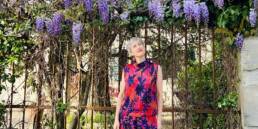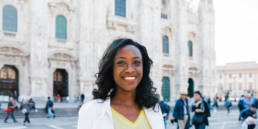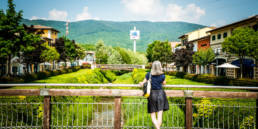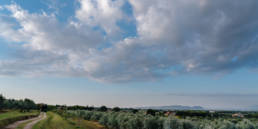In April 2019, after many months of uncomfortable symptoms, excruciating pain and scary weight loss, I was diagnosed with Ulcerative Colitis (UC), a chronic non-contagious disease of the immune system that falls into the category of IBD (inflammatory bowel disease). The diagnosis was a blessing as it meant I could start a path towards recovery, but dealing with this disease has also meant living a more restricted life and dealing with physical challenges. It’s meant a lot of self-control and also understanding, of knowing that I’ll have this forever and that when I’m sick, it’s not my fault. It’s something that conditions me and defines me, but I’m determined to fight it and try to live the best life possible despite it.
May 19th every year is World IBD Day, and to help raise awareness about this disease, this is personal story about living with Ulcerative Colitis in Italy, as well as traveling with IBD. Since I published this article in 2019, I’ve received dozens of emails from people who have found it useful and asked me further questions in light of their moving to Italy with IBD or upcoming travels, so I’ve integrated the article to make it as useful as possible to readers. If you suffer from gastrointestinal problems, food allergies, Crohns, Colitis, Celiac or other autoimmune diseases, I hope that reading about my experience might help you.

My IBD Story: Suffering and diagnosis
Over the Christmas holidays, at the end of 2018, I started having frequent urges to go to the bathroom. This was the first really clear symptom of IBD, but of course it would be months, and many rolls of toilet paper, later until I would know that. I’ve always had an “iffy tummy,” with some strong food sensitivities, and stress has always gone to my stomach, so I chalked it up to that. After ten days, I happened to go to my family doctor for my annual certificate of good health that permits me to go to the gym (mainly it’s an electrocardiogram), and I told him about the issue. He said I must have overeaten at Christmas and to take probiotics.
I can’t say that late 2018 was a great period for me. I was under a particular amount of stress as my father in law was very sick and I lacked the awesome support of my husband, who is my rock and also his entire family’s rock and he had a lot going on. I’d been having flare ups of my rheumatoid arthritis, or so it seemed, and had been to the immunologist to complain, though his answer was that I was lucky my meds were working so well and that I had only that pain and not worse. There was a period I could barely walk for pain in my feet and hips, but some very ugly shoes made it better. There was a strange pain that seemed like it derived from my sciatic nerve that made it difficult to sit on my office chair all day. Sometimes, it seemed to travel through the whole center of my body. I adapted by carrying a pillow everywhere to sit on, and using an electric heating pad that I must say is really a saviour. If you have arthritis you know that I mean. It sucks. I have had it for about 15 years but it was mostly under control with weekly injections of a biological drug (Enbrel); I didn’t particularly let it condition my life.
What I came to refer to as “my pain in the butt” never left me (it still hasn’t) and it continued to get worse, while the bathrooming issue also continued. It didn’t seem to matter what I ate, it never stayed in me for more than five minutes. I started having really low energy and losing weight. Three months in, I went to the doctor and he agreed it was time to see a gastrointerologist. Here in Italy, your family doctor gives you a script for specialist tests which you then request to the public system. It took about two weeks of trying to finally get someone to tell me that no gastro appointments were available for the year to come in the system. Luckily, we have a two-tier healthcare system, and I have private insurance, so I booked for a few weeks out with a guy who is top in the field.
While I waited, things got worse. The “pain in the butt” was unbearable, and I had strong pains in my left side, kind of like period cramps. Finally the appointment day came. He examined me and he said he thought I had quite bad digestion and prescribed a strict, very strange diet as well as ayurvedic supplements. Standout elements of the diet were: cheese could be no younger than 5 years, focus on fish and game meat (ideal as I was a pescatarian but hadn’t eaten meat in 20 years!), wine should be red and aged more than four years, all vegetables should be cooked, the only starch permitted was basmati rice, and I should sip warm water every 20 minutes all day.
It took only five days with this regime to find myself curled up in a ball on the couch, crying and unable to eat or function. A call to the same doctor got me a colonoscopy five days after that, and before, I drank liquids and had friends and colleagues come babysit me because it felt risky to stand up if I were alone in the house. I weighed 45 kilos (99 pounds). The more invasive test immediately revealed Ulcerative Colitis, a disease that can only be confirmed by getting up in there and looking at the lining of the GI tract. This tract is inflamed, and in the case of UC, parts of it may be riddled with numerous bleeding ulcers, as was my case. This interferes with one’s ability to absorb nutrients and all that good stuff. For a definition of IBD including chrons and colitis, please see the Canadian Chrons and Colitis website.

The scary part is that if it is left untreated, UC can kill you. Many people have it much worse than I do; in severe cases surgery is performed to remove the large intestine and rectum. Luckily, I only found this out later on, so didn’t freak out. The first line of treatment usually is a drug called Mesalazine, combined with Cortisone. Not everyone responds well to it, but I did, literally from the first dose. I was taking a lot of these drugs, and it’s not super pleasant, but it worked so that I was able to have my first meal of mush after about three weeks of not eating. I was taking this combined with Enbrel for my arthritis, which was later switched to Humira when I had a flare-up in December 2021.
My IBD diet in Italy: IBD-AID
There are doctors who don’t believe diet plays a factor in IBD, and those who do. Mine was definitely in the diet camp, and suggested I continue the diet he assigned me (though I threw out those ayurvedic pills, I think they caused my total collapse because of some irritant ingredients). His diet, however, was hard for me to follow. To start with, I instinctively knew I should take it easy and eat really soft foods that are easy to digest. Normally after a stomach upset, we’re told to eat rice, white pasta or potatoes, but the doctor’s diet prohibited all of these things. I ate bananas and mushy soup.
The breakthrough for me was discovering a diet called IBD-AID thanks, actually, to a reader of this blog who had become a Facebook friend. I noticed she posted about being in hospital for some drugs by infusion and asked her why, and it turns out she also had UC. It was my second day home and on meds when she told me about this diet. IBD-AID was developed by the University of Massachusetts Medical School‘s Center for Applied Nutrition and not only is it specifically for my disease, but they provide an easy to follow, step by step meal plan, including recipes. There is a list of permitted foods, and best of all, three phases that represent different foods (especially textures) depending on your symptom level.
If you’re interested you can check out their website to fully understand the logic – I’m no scientist. But the idea is that we IBD sufferers have an imbalance of gut bacteria, and that the “bad bacteria,” which feeds on carbs, is extra bad for us and attacks the lining of our GI tract. This sounds hokey, but a lot of research backs up this kind of thing, not just in IBD but also in other auto-immune diseases – in fact, I later found out that there are very similar diets for arthritis as well as for more serious diseases like MS (see this book by a doctor who reversed her own MS symptoms with diet).

The diet has a lot in common with Paleo, and has the downside of being completely incompatible with the Mediterranean diet as it has been interpreted by modern society, i.e. pasta and pizza. In truth, the original Mediterranean diet would have more to do with fish, vegetables and drizzles of olive oil, and that’s where I was headed. I had to stop eating all carbohydrates except oats. Due to my extant food sensitivities, I wasn’t able to eat everything on their food list, but I was willing to give this a shot. The first phase’s food was mostly mush, and although I craved texture, the closest I got to solid food for a while was some oat crackers I found at the health food store. Phase two involves mostly cooked foods and integrates more variety. Phase three, god bless, includes yummy crispy salads, which I was very happy to see after about six months.
This is a strict diet, and I knew that attempts to eat things not on the diet were going to cause a setback, so I stuck to it. I made little adjustments for my geographic location, because it has an American bias, and many of the recipes were dependent on ingredients that are common in North America, like peanut butter and sweet potatoes (I did eventually find reliable sources of those here). I also gave up being a life-long vegetarian and started eating organic chicken, because the diet approves of beans and tofu, which would make being vegetarian okay, but my digestive tract does not. Without my daily plate of pasta, I would starve.
It is very important to do food planning and food prep. There is literally only one bought, pre-made food I can eat (those oat crackers), so I have to make sure I always have home-made meals and snacks ready in advance. At the start, I also made a lot of shakes with almond milk. I make oat bread and almond butter cookies, snack on nuts and organic dried fruits, prep cooked vegetables as sides, and make a menu that alternates fish, eggs and poultry. Once I mastered food prep it took me one whole day and one evening per week to make most of my meals. I told my colleagues at work that I needed extra time off to do this. One thing to note is that in Italy, fresh fish and vegetables are available year round, though I calculated that with the IBD-AID diet, the cost of food in our family has gone up by 30-40%, mostly due to integrating fish and meat (as well as peanut butter which is a rare item here) where I ate mostly rice and pasta before.
The drugs were working from day one, and things weren’t perfect, but I got my energy back, my skin colour changed, my nails hardened and eventually my hair stopped falling out (about 8 months later). I had a relapse a few months later when I tried to get off the drugs a bit too quickly because I hadn’t been assigned a followup appointment with my doctor (they’re not very proactive here, you have to be) and had misunderstood how to wean. At this point I went back to my trusted immunologist, who had been treating my RA, and on Christmas Eve, 2019, he switched me to a different injected biological drug that is approved for both diseases. Humira (the drug) and I get along well; after 2.5 months it cleared up most of my symptoms. Three years later, I’m still taking injections and a barrage of medications in various formats, and I still have flare-ups every few months despite my best efforts. Working from home makes it easier to prepare my own meals without so much advance planning, and also gives me safer access to my own bathroom.
Healing, sports and travel with UC
UC limits your life. Some people can just take the drugs and be fine, or are okay with relapses. I found I needed the diet, and that meant a lot of restrictions, namely on travel and on eating out. My job used to involve a fair amount of both of these things. I also have a pretty active life – I love tennis, hiking and working out at the gym. If I concentrated on my health, I figured could do sports and travel again.
I put myself to the travel test immediately. It wasn’t my choice exactly. We had a major trip to Morocco in late April 2019, three weeks after my diagnosis. As I hadn’t been feeling well already while booking it, I had gone the luxury route. And being the week of Easter, it wasn’t cheap. As I lay in bed unable to eat or stand up on my own, I started trying to cancel the trip, and found that I wouldn’t get much money back. I tried to sell it, but no bites. The thought of throwing that away, and not having this hard-earned trip with my husband after a really tough year, was making me terribly depressed. A few days before we were supposed to leave, Tommaso said “why don’t we just go. You can pack a bunch of food, write ahead to the riad (small hotel) to have them make special things, and we can just sit around and look at the sky if you don’t feel well enough to do stuff.” We also had trip cancellation and repatriation insurance that was active during the trip, but didn’t apply to canceling before the trip!

And so we did. I packed a suitcase with 8 kilos of food including the famous oat crackers, tuna, peanut butter and honey, applesauce, non-dairy sugarless milk, herbal tea (turns out mint tea was great) and a “mix” for oat-flour pancakes, the best recipe of the whole IBD-AID arsenal. We arrived in Marrakesh where the kind ladies at the riad had made me a tajine with lovely cooked vegetables and no spices. My first morning was spent with them in the kitchen making oat pancakes, communicating in bad French and them in Arabic. They were wonderful and humoured me while I stuck to my awful diet for three meals per day at the riad. We took it easy, but with the calorie intake I was able to walk enough to see the main sights with our private guide. We didn’t go to the desert (miles of sand are IBD-incompatible) or eat any street food but the trip healed me in a way that staying home would not. I shared nothing of the trip on social media, and in fact had deleted socials from my phone for a full digital detox.

I had a heavy spring of travel: at the end of May, I had to go to Slovenia for work for five days. The first night was a social dinner at a restaurant and they brought me two white fishes done on the grill, it was plentiful… and that had to keep me going for a few days, as conference food is a disaster and I didn’t get much else for the rest of the time. Luckily I had my emergency peanut butter, tuna and crackers.

A few months of cooked fish and cooked vegetables and I had enough energy to hit the tennis court again in June. My colleagues got me a new tennis outfit for my birthday, since I was now a size small, not to mention down three bra sizes. I was doing well, but I still couldn’t really sit down without pain. Remember the “pain in the ass”? It was still really bad, and no massage or physiotherapy could fix it. I hypothesized that the inflammation of the colon spread to inflame the piriformis muscle.

In September I decided it was time to rebuild – I forgot to mention that cortisone eats muscle, and I was on cortisone for three months so I had zero muscles! Even the old people classes at the gym were too hard for me, so I treated myself to a personal trainer (this is something that is relatively affordable in Italy). Tiziano is a nutritionist and specializes in functional training and pilates and he immediately noticed that I wasn’t activating my glutes, and that I had a slightly flattened spine and reduced lower back mobility. I immediately got an MRI, because there is another auto-immune disease with related symptoms and thankfully I don’t have that. Meanwhile Tiziano taught me how to activate my muscles and increase mobility. Six months together and I was stronger than ever, and that showed in my tennis game too.
The COVID-19 lockdown didn’t do wonders for my physical health, as staying moving and frequent exercise are essential to keeping my UC and RA under control. Being immunosupressed for both of these diseases puts me in an at-risk category, which meant first access to vaccines. Summers here in Italy have been relatively free and open. As things are opening up more and restrictions are falling now in the spring of 2022, I’m less protected and have to remain socially isolated.
Eating out in Italy with IBD / UC
If you’ve got IBD or any intestinal disease, the two big issues when you travel are access to bathrooms and what to eat. I’ve gotten numerous questions from readers asking if it is easy to find IBD-AID diet compatible foods in restaurants in Italy. There is no short answer to this question: all of us have slightly adapted or different diets based on what we can tolerate, and we may have moments when we can cheat or risk more, and others when we know we just need a homemade soup. My main suggestion is, if possible, to stay in an apartment. If you are anti-airbnb, there aren’t many options for this, however in Italy there is a category of hotel called “residenza” that is something like an all-suite apartment hotel. They tend to be found more in vacation locations like on the coast. In Florence, I recently checked out Residenza Leopoldo for a friend and found it quiet and nicely equipped in a well-connected residential area so I’m happy to be able to recommend that.
If you’ve got your own kitchen, I suggest bringing the ingredients you’re most familiar with and that you know you will need. For example, I travel with oat flour, almond flour and baking soda so I know I can prepare my own sweets or pancakes. I also usually pack almond milk and herbal teas. In fact, you can get pretty much all the ingredients needed for the IBD-AID diet in Florence, and probably in other large cities where there are supermarkets with a range of less traditional foods. Oats are called avena and they don’t usually sell oat flour, so I grind my own in a coffee grinder. Most stores sell just quick oats, though some sell small bags of regular oats, these are found in the cereal section. Almond flour is in the baking section or near the nuts, and is very expensive. Coconut flour is not common and neither is coconut oil. Coconut sugar can be purchased at most health food stores and is carried by the supermarket Esselunga. Baking soda is called bicarbonato di sodio and is kept near the mineral waters, in huge containers – most people use it for cleaning. Fresh fish, white meats and vegetables are of course plentiful and can easily be purchased at supermarkets or smaller local stores anywhere in the country.
As for eating in restaurants in Italy while trying to follow an autoimmune diet of any sort, it’s a challenge. I tend to differentiate between “traditional” restaurants and more “international style ones”. Visitors rightly would want to go to some of the traditional ones, but I find them harder to eat at. As you know, meals here usually open with a primo and that is a starch-based dish (pasta or rice). Sometimes you just stop there. Sometimes you eat a secondo of meat or fish. Unless you are on the coast, the second course tends to be meat-based and most of the time that is red meat. If you don’t eat red meat but just chicken, it gets difficult to explain this limitation because they consider pork and rabbit to be in the same “white meat” category. Chicken is generally not considered a special food, so not many restaurants have it unless it’s a place that does grilled meat, in which case you might get a delicious chicken “sotto mattone”, cooked under a brick in a wood oven, which is the best! If you are vegetarian, starchless options will be very slim pickings: in Florence, the ribollita is a hearty stew with beans in it that they tend to offer vegetarians, but its first ingredient is white bread! You will be offered grilled vegetables or a raw salad (which isn’t OK when you’re in a UC flare!). In traditional restaurants in central Italy, note that most of the time the meat doesn’t come with any sides, so be sure to order a contorno (side dish) which usually is potatoes or spinach, or green salad. Garlic is added to most cooked vegetables here, so if you happen to be allergic or sensitive to that like I am, you’d better make yourself very clear on the matter. Otherwise, the non-starch items on most typical menus include a cheese plate and sometimes some kind of vegetable flan. We tend to have better luck in hotel restaurants, on the coast with fish restaurants, and in some internationally oriented, modern style restaurants. For example, hotel or high-end restaurants will usually have a fish course and they tend to also come on a plate with some cooked vegetables; Irene at the Rocco Forte hotel in piazza della Repubblica is a good option, as is Nugolo in the Sant’Ambrogio area. For lunch, I like Floret, which is inside the fancy store Luisa via Roma right near the Duomo (serving a healthy menu with juices, bowls etc) and the Australian-run café Melaleuca on the lungarno who make amazing sweet-potato fries. My best piece of advice is to always ask if they can accommodate your special dietary needs when you write or phone to book your table. If they’re not super nice about it at that time, find somewhere else to eat.
Lessons learned
In many ways, I am very lucky. I live in a place with good access to healthcare, and a public system that covers the very expensive drugs I have been taking for more than a decade, including the one I now take for UC. I am lucky that the doctors diagnosed the UC before it did permanent damage, and that I have supportive people around me, including a husband willing to eat an IBD-AID diet, friends who will let me bring my own food to parties, and bosses who have given me time to take care of myself.
What have I learned about living with ulcerative colitis? I’ve learned that it’s a scary and uncomfortable disease that needs to be addressed urgently if you have symptoms, and for me that meant taking responsibility for my health at all costs. This includes speaking out without embarassment about what is not a typical topic at the dinner table. I’m not afraid to tell people that if I don’t stick to my diet, my colon will bleed, ergo I may be a “difficult” guest at a press event, or simply I won’t attend. I’ve found out what I need to do, personally, to keep this disease under control, for now at least. I also know that may change in the future, and I hope I can be wise about dealing with it then, too.
If you have any symptoms of IBD, don’t lie to yourself. Get a colonoscopy and a gastroscopy and get to the “bottom of it,” so to speak. Hound your doctor, get specialists, get tests, and stick to your treatment program. Canada, the UK and the USA have Chrons and Colitis Societies or Associations that provide information. In Italy there is Amici Onlus (NB their dietary recommendations are “traditional” and don’t match with IBD-AID). If there’s anything I can do to help you, please comment or send me an email to info (at) arttrav.com.
Updated in May 2022
Sign up to receive future blog posts by email
Alexandra Korey
Alexandra Korey aka @arttrav on social media, is a Florence-based writer and digital consultant. Her blog, ArtTrav has been online since 2004.
Related Posts
December 31, 2023
How sewing saved my sabbatical
April 30, 2022
Moving to Italy: a course to make your dream come true
September 21, 2020




